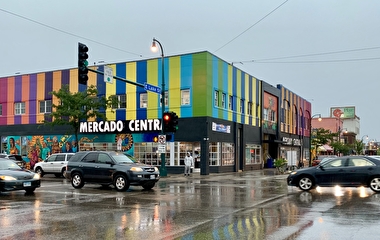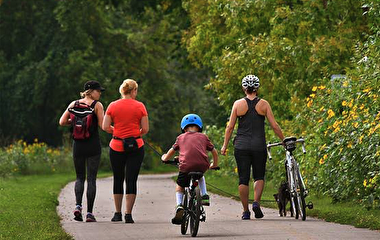When you see people riding a city bus, it seems logical to assume that every one of those passengers is being treated equally. But U of M researchers are exploring several aspects of our transportation systems that show just how their designs put women at a disadvantage.
Those disparities are basic features of transportation infrastructure, the researchers say in a series of articles posted by the Gender Policy Report, published by the Center on Women, Gender, and Public Policy at the Humphrey School of Public Affairs. The issues the researchers address primarily revolve around public transportation—such as buses and commuter trains—and bicycling.
Building on previous research by Humphrey School professor Yingling Fan, Ania McDonnell studies how transportation professionals can develop effective solutions in their own communities.
Women who ride on public transit report that they often feel unsafe while waiting at platforms or stops and are sometimes harassed, according to Fan’s research. They also feel unsafe walking home from the bus or train stop, especially at night after working a late shift. Women who work low-income or hourly jobs are disproportionately affected and are less likely to have other transportation options available to them.
McDonnell, a Master of Public Policy candidate at the Humphrey School, believes public transportation service providers should have meaningful discussions with their diverse passengers to gain a better understanding of their safety concerns. “And they should take steps toward implementing policies that will address those needs so that women are not forced to find more costly or inefficient ways to reach their destinations safely,” she says.
Public transportation also fails to account for the ways that women typically move around. One example is “trip chaining,” in which a rider makes multiple stops for school or daycare, errands, and appointments. These caregiving tasks disproportionately fall to women regardless of their socioeconomic class, and they occupy a significant portion of the day, McDonnell says.
A related phenomenon, time poverty, often causes women to take part-time jobs closer to home, limiting their employment opportunities.
McDonnell says addressing these gender disparities will require federal, state, and local policies that address the different mobility needs of men and women. Collecting adequate data is also key to ensure that transportation systems are designed and built for all people.
The gender disparity in transportation extends to bicycling as well, says Humphrey School professor Greg Lindsey. Women are far less likely to bicycle than men, he says, and one major reason is that women are concerned about their safety while biking.
Recent research by Lindsey’s students for Hennepin County shows this concern is warranted. A field experiment they conducted yielded the unexpected result that vehicle drivers were significantly more likely to encroach—to pass closer than three feet—on a female cyclist than on male cyclists. Under Minnesota law, drivers are required to provide cyclists a berth of at least three feet.
The vast majority of drivers kept a safe distance from the cyclists. But of the 33 encroachments that occurred, 73 percent were on the female rider.
Lindsey says his study underscores the need for greater investment in safer facilities like protected bike lanes.
(Reprinted and adapted with permission from Humphrey School News, Aug. 8, 2019, and The Gender Policy Report.)



